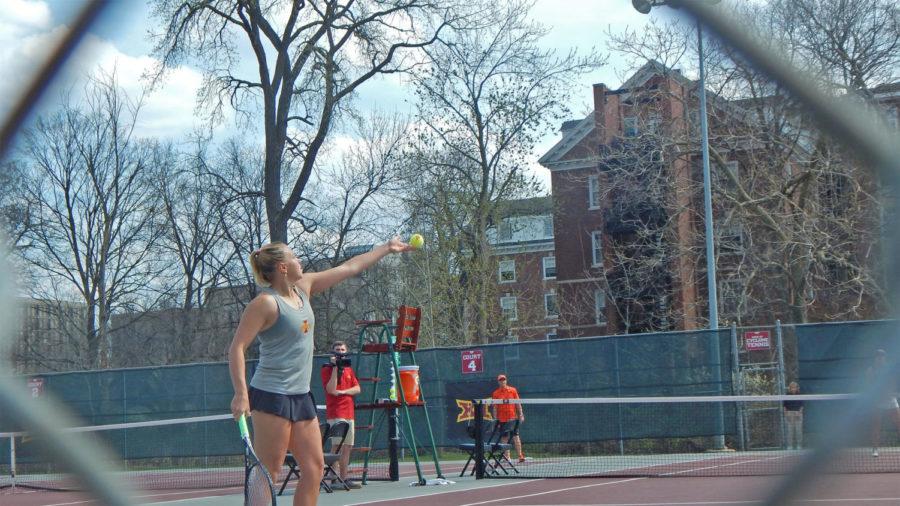ISU tennis expands boundaries in effort to improve recruiting
Senior Ksenia Pronina begins her serve during her doubles match against No. 10 Oklahoma State. Oklahoma State defeated Iowa State 4-0.
April 29, 2015
It can be a difficult process to sign an international player to an American university. Imagine signing six different athletes from six different countries to the same roster.
The 2014-15 tennis roster had six of nine players go through the international recruitment process from countries like Germany, Spain, Colombia, Croatia, Norway and Canada. The time, effort and money being put into international signing is unquantifiable, especially recruiting two-thirds of the roster internationally.
“International signing is a more complicated process than United States signing because there are more rules and laws to abide to,” said coach Armando Espinosa. “It costs money and requires time, but the players we bring from these countries have contributed so much to this [Iowa State tennis] program.”
Senior Ksenia Pronina said there are two options for international players to be recruited by American colleges. One is taking the initiative to email and contact coaches personally and do the work by yourself as an individual and player. The other option, the one Pronina chose, is to pay a recruiting agency to help her with the process and take some of the workload off the players’ shoulders.
Pronina said the downside to hiring a recruiting agency is hiring the wrong one. Some agencies don’t look at what’s best for the player, but rather the money that is being given to the company. Luckily for Pronina, she thinks she chose the right agency.
“My agency kept in touch with me all the time to make sure deadlines were met and my college preferences were updated,” Pronina said. “If it wasn’t for the agency, I don’t know if I would’ve been going to an American college to play tennis.”
Sophomore Samantha Budai chose the other option, which is to complete all the tasks at hand by herself and not with an agency. Budai sent emails and performance videos out to coaches all around the United States and in the end reached an agreement with Iowa State.
Budai said she would have hired an agency, but the amount of work outweighs the expenses of hiring one.
“An agency does relieve a lot of stress, but I enjoy doing the work individually because I have more control of choosing my schools and other aspects of the recruiting process,” Budai said.
Espinosa said the first step of recruiting an international player is watching their recruiting video on YouTube. If they decide the player is worth looking at more, then the coach will contact the player to talk on the phone.
Espinosa said the hardest decision in the process is whether to give the scholarship to the player immediately or travel to one of their tournaments and watch them play.
After the decision is made to sign the player, Espinosa will talk to the family of the player to make sure they’re comfortable about the process. Then the player comes to Iowa State to play tennis.
“It seems like an easier process than what most people are thinking, but it’s not that easy,” Espinosa said. “The hardest part is finding the players that are capable of producing the talent needed for Iowa State tennis.”
Espinosa, a native of Mexico City, Mexico, has been known for signing many international players throughout his time as head coach at Iowa State. He said the field in the U.S. is very competitive and, so far, he believes the international players he’s signed have worked out well for the tennis program.
Since there are so many international players in the world, there’s only one way to tell players apart from one another.
“You’ve got to be good,” Pronina said. “That’s all I can say. If you’re not good, you’re not going to be noticed.”
Budai said it’s interesting to compare the competition level as well as the game style of the different countries that each player is from.
Espinosa said he would continue to emphasize international recruiting for future years because it’s been working well ever since he’s been hired as the head coach.
“International players are essential for our program here at Iowa State,” Espinosa said. “Even though it’s a difficult process, it’s beyond worth it because it benefits our team and our future.”







